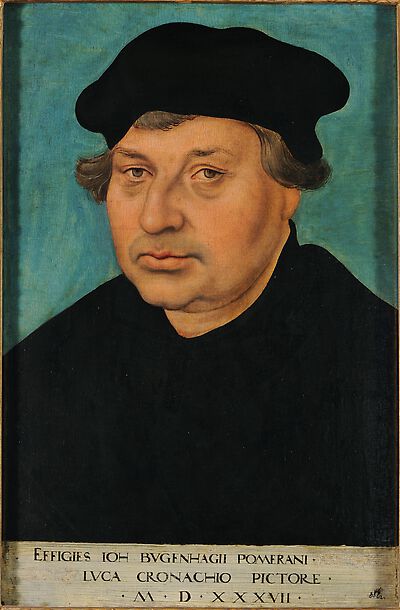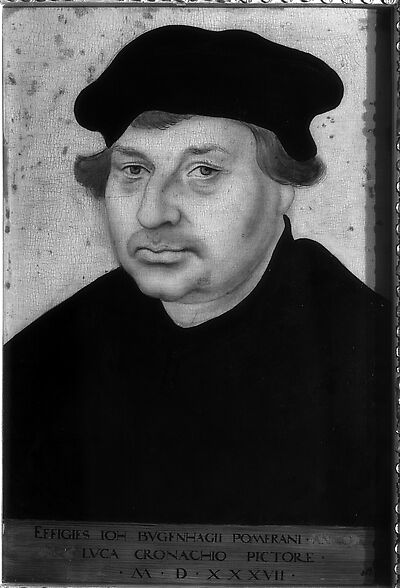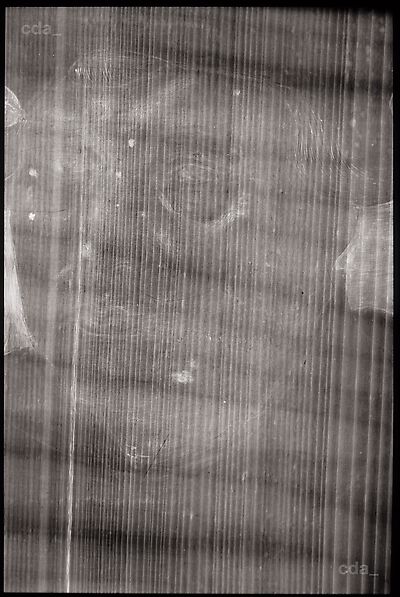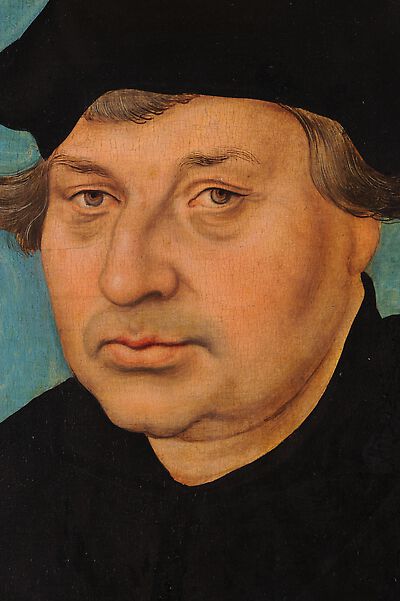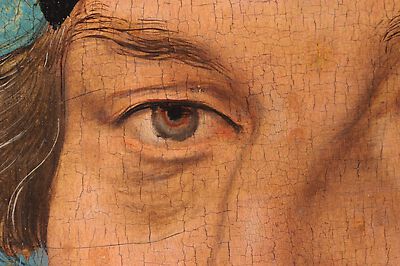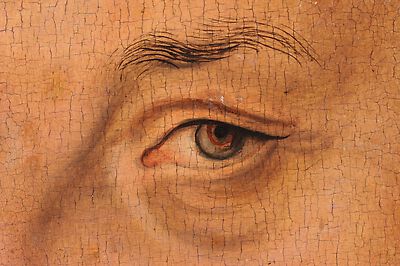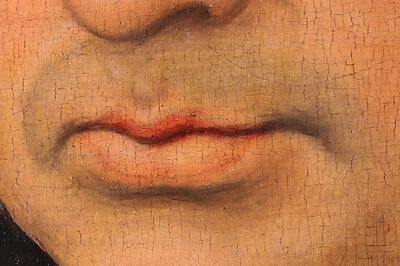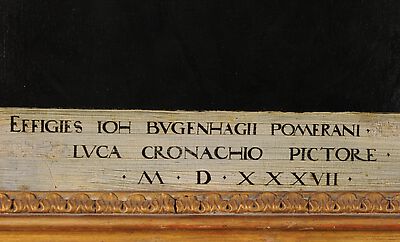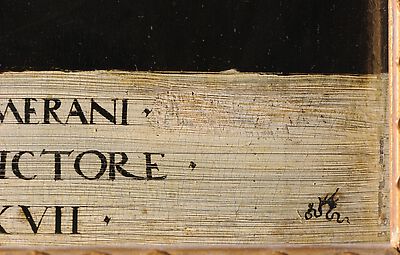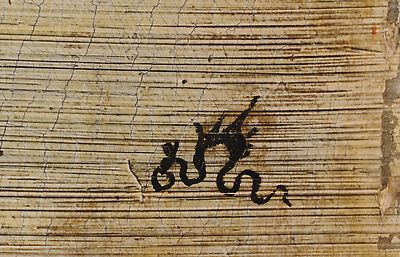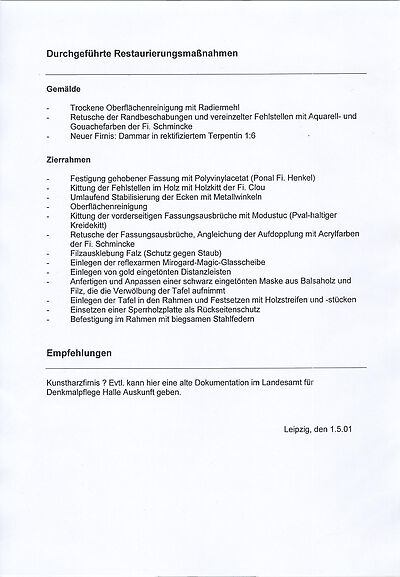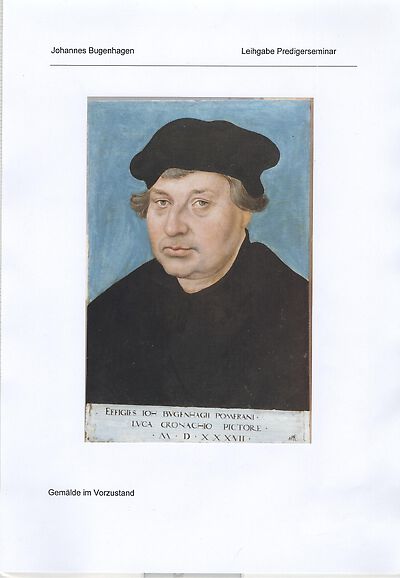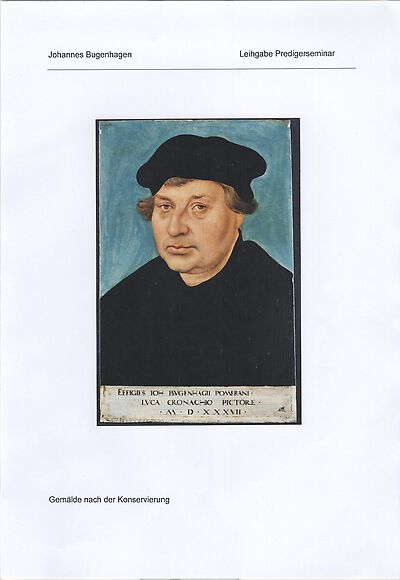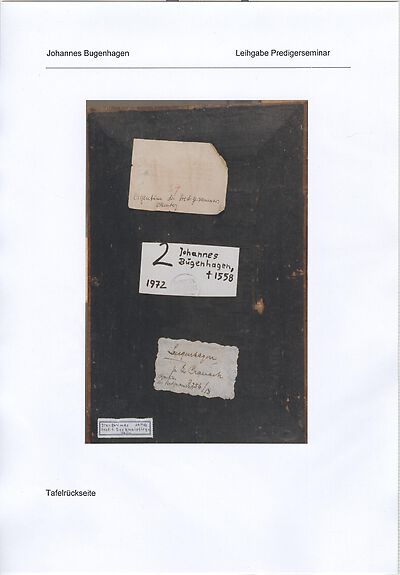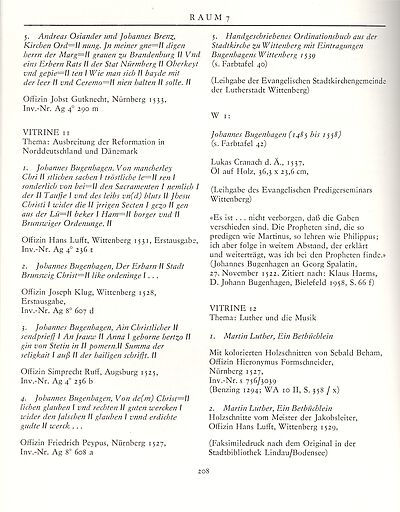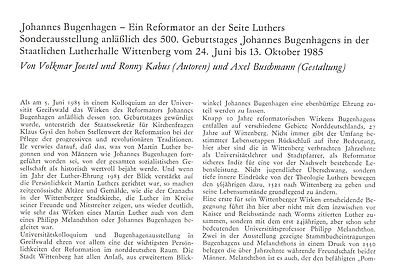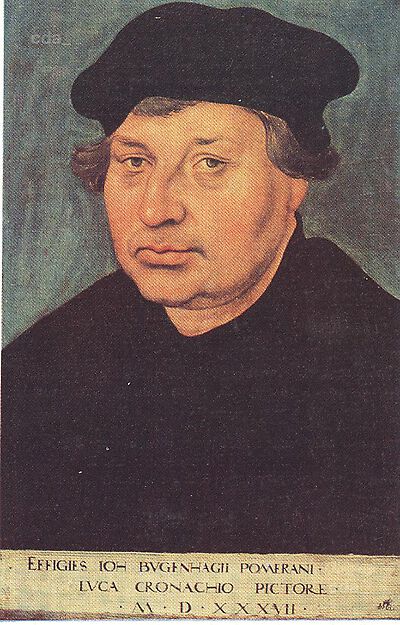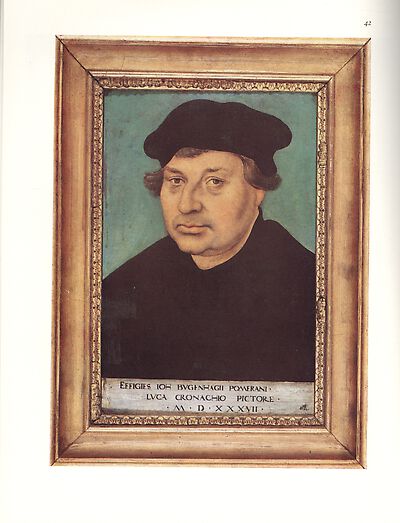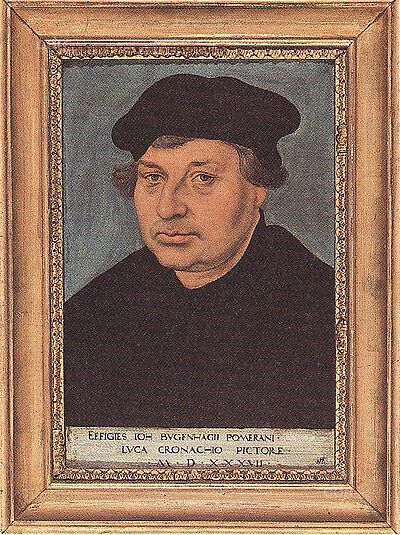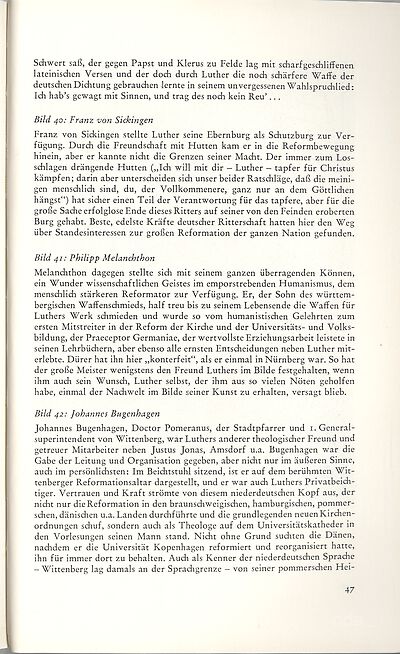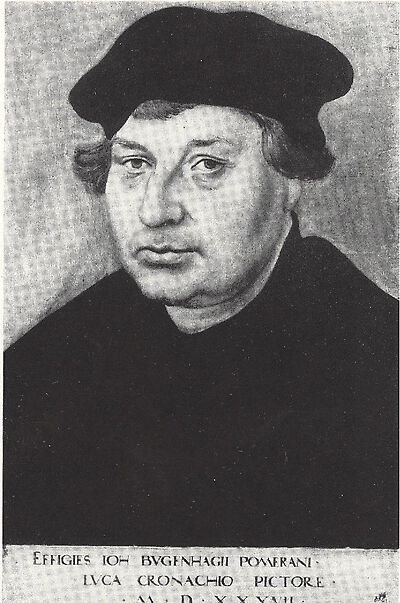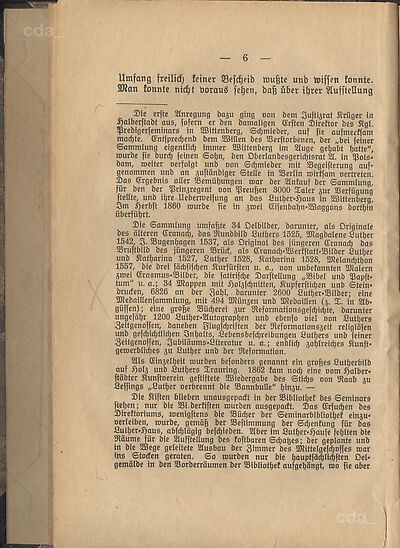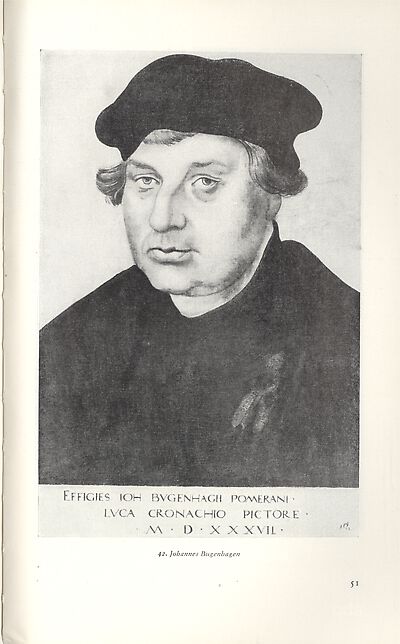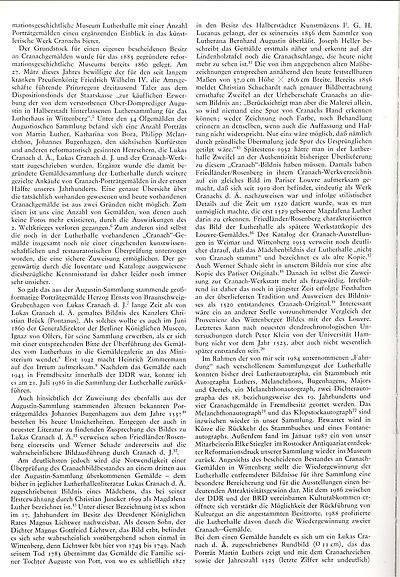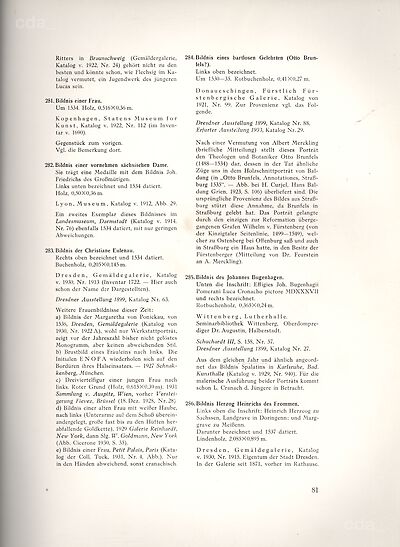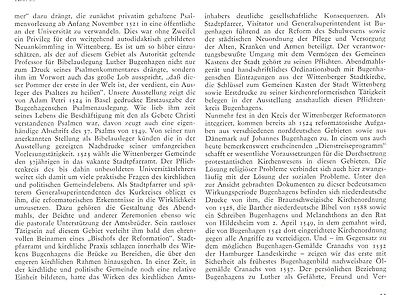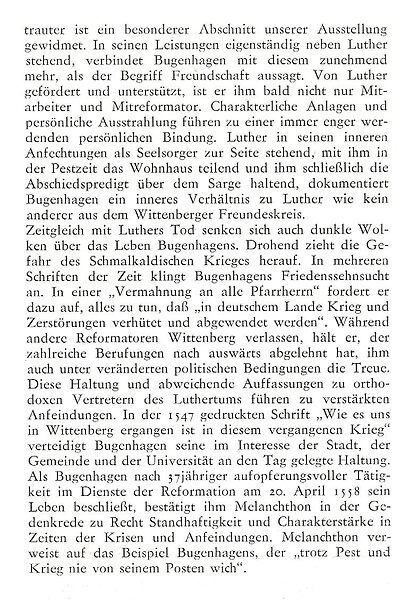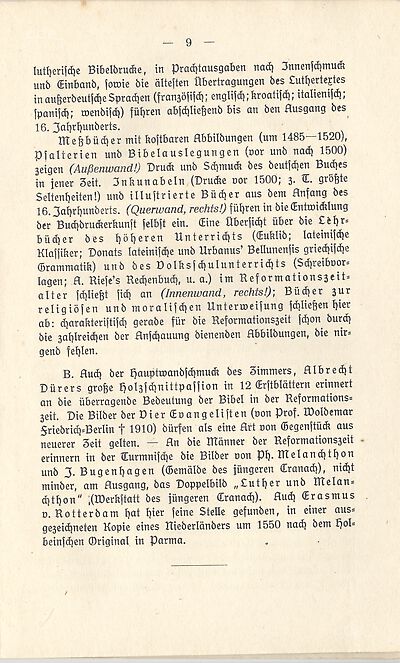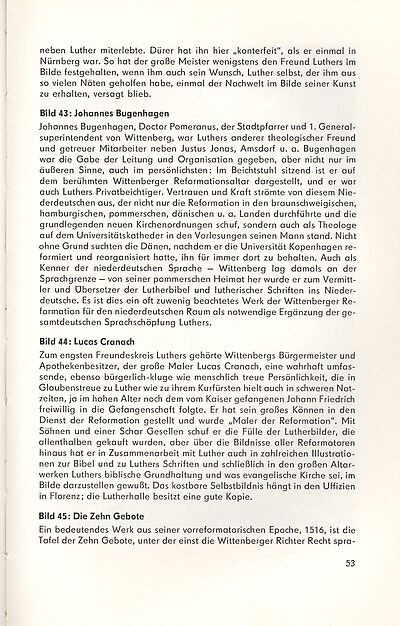The work is considered to be a portrait of the theologian Johannes Bugenhagen (1485-1558). Depicted with his head crowned with a beret and set against a light blue background he occupies the upper half of the painting. A contemporary and friend of Cranach he is togther with Melanchthon regarded as a confidant of Luther. Since 1521 Bugenhagen was active in the University of Wittenberg where he worked closely with Luther. In 1524 he became the second reformation theologian to be married to Walpurga Bugenhagen (1500 – 1569). An appointment to the Nicolaikirche in Hamburg failed. [1] On the 9. October 1528 he returned to Hamburg where a generous reception awaited him. From the end of 1530 until the spring of 1532 he was in Lübeck and lived for almost two full years – 1537-1539 - in Copenhagen. In all of these locations he developed a new church constitution. He returned to Wittenberg in 1539.
Thw small format of the portrait suggests it was conceived for private use.
Very few verified portraits of Bugenhagen exist. The Lady altar by Lucas Cranach the Elder in the parish church of Wittenberg can be cited as a painted portrait. It was handed over during a service on the 24. April 1547[2]. The right panel depicts Johannes Bugenhagen at confession.[3]
Cranach the Elder created a number of portraits in a similar manner to that of the Portrait of Bugenhagen from 1537. Striking in this context are the contemporaneous portraits of Georg Spalatin and Philipp Melanchthon that both feature the same composition, size and date.[4]
The subtle execution of the portraits recalls early Netherlandish portraiture of the time and according to Heydenreich Cranach’s encounter with Netherlandish painting and art markets provided important stimuli for his artistic work.[5]
In 1974 Schade described the bearing of sitters from before the Wittenberg period as withdrawn and the expression of the faces as subdued; they gaze beyond the viewer. In contrast the depictions from the Wittenberg period appear more open-minded [6]. The faces set against a neutral background meet the viewer’s gaze and answer.[7]
Further known portraits of the theologian by Cranach the Younger are a portrait of Johannes Bugenhagen from the year 1551[8] as well as a little-known portrait in Leipzig [9] (property of the Stadtmuseum, 71 x 49 cm) from the year 1579. In addition Cranach the Younger created an Epitaph for Paul Eber in 1569, which is in the same parish church a Cranach’s Lady altar. [10] Bugenhagen and his associates are depicted on the Epitaph as workers in the Lord’s vineyard (Mt 20, 1-16).
Opinions in art historical research are divided regarding the question of the authorship of the portrait from 1537. Schade 1974 interprets the signature on the portrait of Bugenhagen - which is unusual for later years - as clear evidence of an early independent work by the son. [11] Friedländer/Rosenberg also consider that the Portrait of Bugenhagen as well as that of Spalatin could be attributed to Cranach the Younger.[12]
When focusing on details the rendering of the hair and the ear are striking. The left ear is indicated but not worked up. Comparison with the portraits of Spalatin and Melanchthon from the same year show that in these works the artist avoided painting the ear by the skillful positioning of the head attire and the hair. In the portrait of Spalatin the right ear is indicated by a shadow, which is inaccurate and is therefore unconvincing, whereas in that of Melanchthon the earlobe is barely visible through the hair.
The subtle painting style of the Bugenhagen portrait is found again on the portrait of Spalatin as is the particular manner of paint application, whereby single hairs were applied in a second stage after the form was defined by an underlying layer. The execution of Melanchthon followed a similar pattern, however of a different quality. Here more emphasis is made on the fluid transitions to the underlying layer and an extraordinary individuality of single hairs. A conclusive judgment cannot be drawn regarding the informative value of the representation of the hair as the lacking subtle finish of single hairs could be due to the condition of the painting.
Furthermore the signatures on the portraits of Spalatin and Bugenhagen exhibit one parallelism: both have dragons’ wings. Melanchthon’s portrait on the other hand is the only one of the three paintings that made the change from the dragon’s to the bird’s wings. A thorough examination of the details in the signature on the portraits of Spalatin and Bugenhagen revealed a close proximity between the two.
Although the portrayed resemblance bears more similarity with the depiction by Cranach the Elder on the right wing panel of the altar in the Marienkirche Wittenberg than with other versions by Cranach the Younger, the comparable diligence in the finish of the hair speaks in favour of an attribution to Cranach the Younger. Thus the suggestion by Friedländer/Rosenberg that the portrait of Bugenhagen from 1537 could be by the Younger - taking some workshop participation into account - is justified.
[Claudia Adamczyk, Tanja Steinfelser 2013]
[1] The St. Nikolai church in Hamburg owns a portrait of Bugenhagen, which was on permanent loan to the Hamburg Kunsthalle until 2010. (verbal communication from Anne Barz 6.2.2012); however rescent research on bugenhagen suggests it may not be a portrait (letter from Probst Claussen, St. Nikolai, 10.2.2013).
[2] Thulin, Oskar: Cranach Altäre der Reformation, Berlin 1955, p. 9.
[3] Thulin, Oskar: Cranach Altäre der Reformation, Berlin 1955, p. 21.
[4] Jacob-Friesen, Holger: Lucas Cranach d. Ä. - Georg Spalatin – Philipp Melanchthon, in: Rainer Stamm (ed.), Lucas Cranach der Schnellste, Bremen 2009, p.15.
[5] see Heydenreich, Gunnar: Reisende Bilder im Wandel, in: Messling, Guido (ed.), Die Welt des Lucas Cranach, Brüssel 2010, p. 66.
[6] see Schade, Werner: Die Malerfamilie Cranach, Dresden, Verlag der Kunst 1974, p. 51
[7] see Schade, Werner: Die Malerfamilie Cranach, Dresden, Verlag der Kunst 1974, p. 51
[8] see Koepplin, Tilman (eds.): Lukas Cranach. Gemälde, Zeichnungen, Druckgraphik, Exhib. Cat. Kunstmuseum Basel, Basel/ Stuttgart 1974, p.715; property of the Museums der Stadt Leipzig, wood, 71 x 49 cm
[9] Leder, Hans-Günter / Buske, Norbert: Reform und Ordnung aus dem Wort – Johannes Bugenhagen und die Reformation im Herzogtum Pommern, Berlin 1985, Fig. 21.
[10] see Steinwachs, Albrecht/Pietsch. Jürgen: Der Weinberg des Herren – Lucas Cranach d.J., Lutherstadt Wittenberg, 2002.
[11] see Schade, Werner: Die Malerfamilie Cranach, Dresden 1974, p. 79.
[12] see Friedländer, Max/ Rosenberg, Jakob: Die Gemälde von Lucas Cranach, Basel 1979, p.140.
